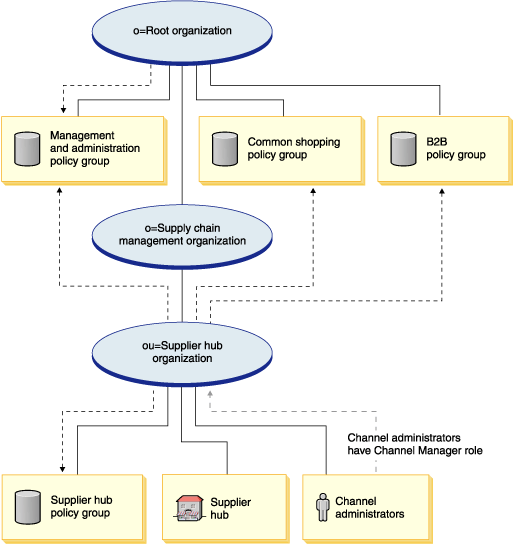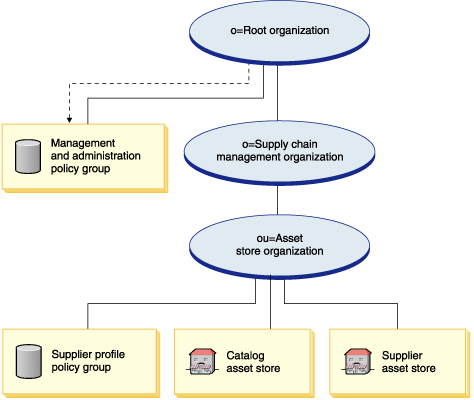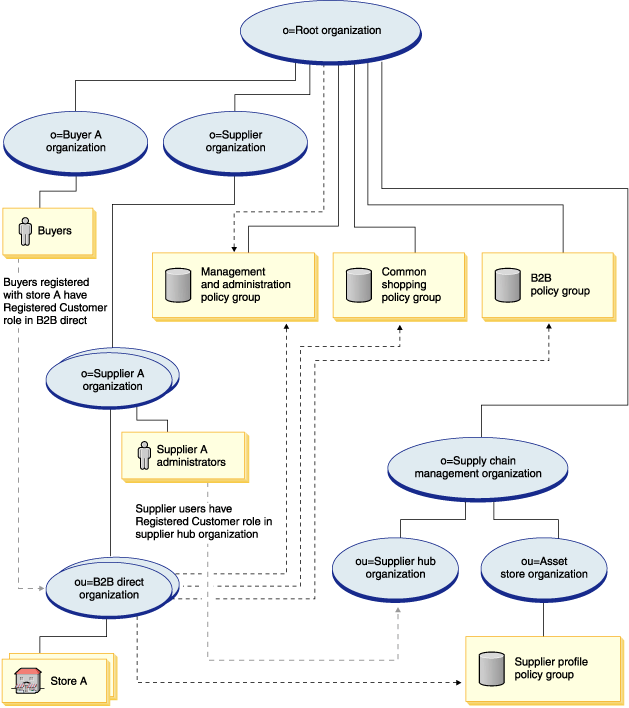Supply Chain - supplier hub organization structure
The Supply Chain - supplier hub organization structure consists of the supplier hub, asset store and supplier organization.
Supplier hub
In these diagrams, describing a basic supply chain organization structure, the root organization owns and subscribes to the default policy groups as described in Access control policies and policy group structure.


The supplier hub organization subscribes directly to the management and administration policy group, the common shopping policy group, the B2B policy group and owns and subscribes to the Supplier hub policy group. As a result, these policies apply to the channel administrators, who are directly under the supplier hub organization, as well as to the supplier hub.
The Supplier hub policy group contains the following policies:
- AllUsersForSupplierHubExecuteSupplierHubAllUsersViews
- RegisteredCustomersForOrgForSupplierHubExecuteSupplierHubRegisteredCustomerViews
- ContractAdministratorsForChannelOrgExecuteCreateCommandsOnMemberResource
- ContractAdministratorsForChannelOrgExecuteContractDeployCommandsOnContractResource
- ContractAdministratorsForChannelOrgDisplayContractDatabeanResourceGroup
Asset store


The asset store organization does not subscribe directly to any policy groups. As a result it inherits the management and administration policy group from the root organization. These policies apply to the asset store organization and the asset stores that it owns. The asset store organization owns the supplier profile policy group, but does not subscribe to it.
The individual supplier's B2B direct organization will subscribe to the supplier profile policy group when the supplier store is created.
Supplier organization


The supplier organization does not subscribe directly to any policy groups. As a result it inherits the management and administration policy group from the root organization. These policies apply to the supplier organization, the supplier A organizations that it owns, and the supplier A administrators.
The B2B direct organization subscribes directly to the management and administration, the common shopping, B2B and supplier profile policy groups. These policies apply to all stores owned by the B2B direct organization.
The Supplier profile policy group contains the following policies:
- AllUsersForSupplierExecuteSupplierAllUsersViews
- RegisteredCustomersForOrgForSupplierExecuteSupplierRegisteredCustomerViews
Buyers are customers that place orders in a B2B store. All buyers must be owned by a buyer organization. Typically, buyer organizations do not subscribe to any policy groups, since management and administration policies inherited from the root organization are sufficient.
Related concepts